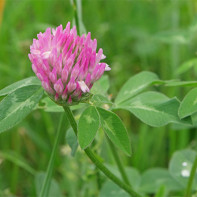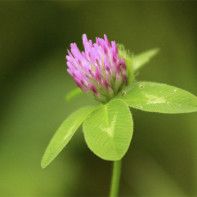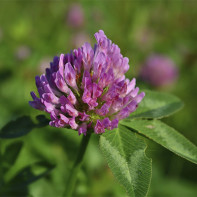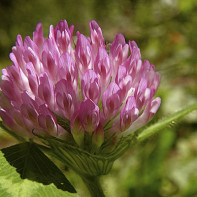Meadow clover: medicinal properties and contraindications
Meadow clover is a perennial herbaceous plant that is widely used in folk medicine and even in cosmetology. It has a long history of use. It is used as a fodder plant and is also considered a good honeybee. In agriculture, it plays an important role because it enriches the soil with nitrogen compounds, and this helps to increase fertility. But, of course, much more important are the medicinal properties of this plant, which will be discussed below.
- Chemical composition
- How it looks and where it grows
- Types
- Gathering and storage
- Therapeutic properties of red clover
- For Women
- For Men
- For Children
- Traditional Medicinal Uses of Red Clover
- For bronchitis and respiratory diseases
- Infections of the genitourinary system.
- Inflammatory diseases of the joints.
- In diseases of the liver
- Hypertension and vascular diseases.
- For coronary heart disease and lower cholesterol
- At gynecological diseases
- At anemia and colds.
- At hemorrhoids
- The use of clover meadow in dermatology and cosmetology
- Types of medicinal compositions
- Tincture
- Infusion
- Decoction
- Tea
- Juice
- The oil extract
- Contraindications for use
- Interesting Facts
Chemical Composition
Currently, studies have established that the above-ground part of the plant during the flowering period contains:
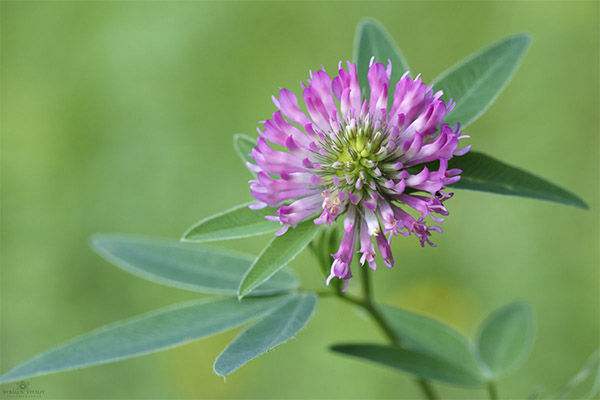
- Plant proteins (up to 25%, depending on the variety, which makes clover a valuable fodder crop).
- Free amino acids.
- Fats (up to 3.5%).
- Fiber, essential for improving digestive processes - up to 26%.
- Vitamins - mainly ascorbic acid, which improves vascular health, as well as carotene, a beneficial effect on vision.
- Flavones and flavonols that have antioxidant properties. In particular, clover contains quercetin with its anti-inflammatory effect.
- Tannins.
- Various trace elements that play an important role in all processes of body functioning.
- Phytoestrogens and plant steroids.
Both in the above-ground part of the plant and in the roots there is a substance trifolysin. Science has proven that it has antifungal properties.
What it looks like and where it grows
Meadow clover is a whole group of plants. Most species are perennials, although biennials can also be found. This plant reaches a height of 15-55 cm. It is characterized by a rather powerful branched stem and characteristic trifoliate leaves. The latter consist of elliptical-shaped plates, solid along the edges, with a white pattern on their upper side in most cases. In many species leaves are folded at night. The tap root of the plant looks interesting. It is most often strongly branched and its offshoots bear nodules, which are nitrogen-absorbing bacterial cultures.
The inflorescences are globular, loose heads that are surrounded by apical leaflets underneath. The flowers are moth-like and most often have a pale pink or dark red hue. This plant blooms from May to September and in the fall its fruit ripens, which botanically is an egg-shaped bean with small flattened seeds having a yellowish or brownish tint.
Meadow clover is common throughout Europe. It also occurs in North Africa (in Tunisia, Morocco and Algeria) and in Asia. In Russia, clover is widespread almost everywhere, the only exception being the Far North. It can be found in meadows (both moderately wet and dry meadows), forest glades, and along the edges of fields. This is true of wildlife, since in many areas meadow clover is grown purposefully - as a fodder crop or to improve soil fertility.
Types
In the olden days, only two species of meadow clover were distinguished - with white and red flowers. Today we know that botanically we can distinguish many more species, such as American (aka downy) clover, alpine clover, etc. All of them have approximately the same properties and insignificant external differences.
Hybrid clover is often confused with meadow clover. It is also a herbaceous perennial with a branched stem, globular inflorescences, and trifoliate leaves, but it is actually an intermediate variant between white clover and red clover (another name for meadow clover). Its distinctive feature is that during the flowering period its corollas change their shade from white-pink to deep red, and then turn brown. Its medicinal virtues are similar to those of meadow clover in that its anti-inflammatory properties enable it to be used to treat angina and bronchitis.
Collection and Storage
In both official and folk medicine, only clover flowers and apical leaves are used as raw materials. It is recommended to collect raw materials immediately during the period of active flowering. Depending on the local climate, it may be as early as May and last as late as September. At this time you need to pluck with your hands or cut with a sharp knife whole inflorescences, but only without peduncles.
After that, the raw material is transferred to willow baskets so that it lies loose and would not be compressed. These baskets are dried in the shade - you can keep them under a roof. The second option - you can speed up the process by using a dryer for fruit and vegetables (but on the condition that the temperature will not exceed 60-70 degrees). It is very important to follow these recommendations, because if the raw material becomes too dry, it will lose its medicinal properties. Properly dried clover heads of inflorescences do not fall off and do not crumble.
Regarding storage, it is best to keep medicinal raw materials in cloth bags. It is best to store them in a dark and dry place. Herbs can be kept only 1 year. But the inflorescences can be stored for 2 years. If done correctly, the herb will smell like dried hay. The presence of a strange odor, as well as the appearance of a bitter taste, indicates that the raw material has gone bad.
Some folk healers recommend using roots of meadow clover. They can also be collected during active flowering or immediately after. Dry them in natural conditions.
Therapeutic Benefits of Red Clover
Research has now proven that meadow clover has anti-inflammatory and wound-healing properties. Also in its leaves and inflorescences contain substances that have choleretic, diuretic, antisclerotic action. A number of studies have shown that this plant also has antitumor properties (unless we are talking about estrogen-dependent neoplasms). In addition, it stops the blood and helps to eliminate toxic substances.
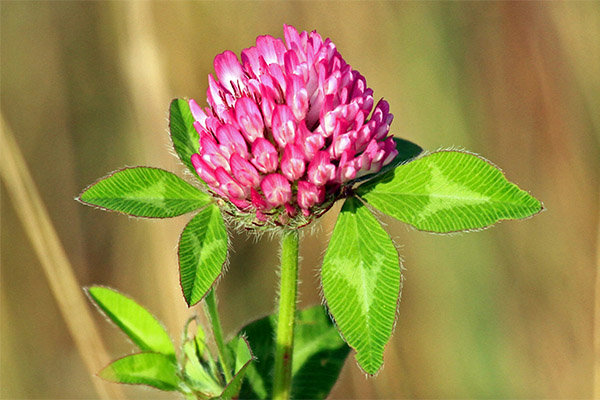
The medicinal properties of clover are so diverse that this plant can be used:
- For anemia caused by iron deficiency.
- Painful menstruation.
- Cystitis and other inflammatory diseases of the urogenital system.
- Rheumatic pains.
- For the treatment of respiratory diseases, including angina and bronchitis, some chronic kidney disease.
- To reduce cholesterol levels, as well as the prevention of atherosclerosis.
As an external agent, compresses of fresh crushed clover leaves are used to stop bleeding. They are also used to treat burns, and in the presence of abscesses and abscesses.
For women
Years of research have shown that meadow clover contains hormone-like substances called phytoestrogens. And in the maximum concentration they are present in the flowers of this plant. In particular, formononetin, daidzein and genistein are contained here. All these phytoestrogens in their action resemble female sex hormones, also because they influence the same receptors.
For women, therefore, clover is useful because:
- Reduces the severity of pain syndrome during menstruation.
- Normalizes the condition of the body at the onset of menopause.
- Has a general healing effect and prevents premature aging. Outwardly it is manifested in the fact that wrinkles become less noticeable, tone of skin and its elasticity increase.
- Restores calcium metabolism and strengthens bones.
- Normalizes cholesterol metabolism.
Thus, the use of meadow clover in large enough quantities performs the same functions as hormone therapy. Only this herb is devoid of so many side effects.
For Men
Clover has anti-inflammatory properties, which is very important for the treatment of urethritis and prostatitis. But it also contains plant steroids. Therefore, clover is considered an excellent remedy in the treatment of erectile dysfunction. This plant has the properties of an aphrodisiac. However, it should be noted that the most effective remedy from this point of view is the tincture of the seeds, not the above-ground part of clover.
In addition, the use of preparations based on this plant helps reduce the level of "bad" cholesterol in the blood and is therefore considered a good tool for the prevention of atherosclerosis, and after all, it is often men who face this problem (in women before menopause it occurs much less frequently).
For children
Children under the age of 3 years are not recommended to give tea and clover infusion for oral use. But older children, such remedies can be useful - for example, to improve digestion, as well as with a tendency to colic and increased gas formation. What is absolutely contraindicated in children is the use of alcoholic tincture.
From clover make decoctions and infusions that are used to prevent and treat rickets in children - on their basis make baths. These remedies can be used in the same way with diathesis to relieve skin inflammation. But it is advisable to first consult with your pediatrician. Because just like any other herbal remedy, they can cause allergies.
The Use of Red Clover in Traditional Medicine
Meadow clover is used for various diseases - depending on the specific diagnosis, it can be a decoction, and infusion, and alcoholic tincture.
With bronchitis and respiratory diseases
The above-ground part of the plant contains substances that help to thin sputum, that is, with bronchitis, clover facilitates the removal of the secret and prevents pneumonia. Already after three days of use, results will be noticeable. Mucolytic and anti-inflammatory properties of clover led to its use in whooping cough and other respiratory diseases, accompanied by congestion of the secretion and wet cough.
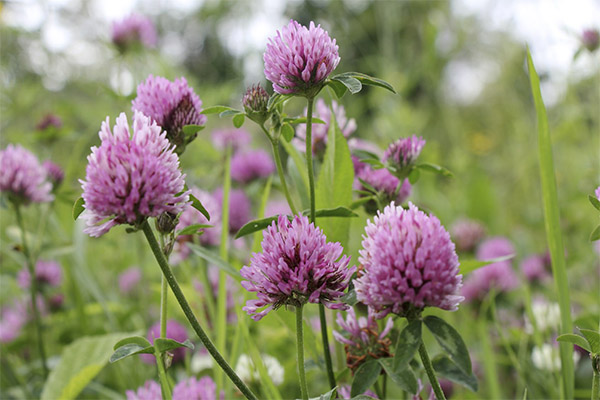
In such cases, you can apply or infusion of flowers and leaves of clover (100 g of raw materials boiled in a glass of water and leave for a day in a thermos, shaking the vessel periodically). Or drink tincture of clover - to the decoction obtained by adding 100 grams of vodka. In any case, the medicine is taken 3-4 times a day before meals.
In infections of the urogenital system
As a rule, in such diseases drink ready-made extract of the plant, because in industrial conditions it is possible to preserve the maximum amount of active substances. In this case, both anti-inflammatory and diuretic properties of clover are important, since it helps to eliminate pathogenic bacteria together with urine. To get the desired diuretic effect, you can drink during the day a glass of clover infusion (the recipe will be presented below), dividing it into 3-4 equal portions. At night it is undesirable to drink it, as it may lead to sleep disturbances.
When using the infusion of clover for several days it is very important to observe the drinking regime. The body should receive at least 2 liters of fluid per day to prevent dehydration and quickly eliminate pathogenic bacteria.
In inflammatory diseases of the joints.
Meadow clover is considered an effective remedy for both arthritis and rheumatism. In this case, it has a complex effect. On the one hand, it is used as an anti-inflammatory agent, on the other - its analgesic effect is important. And since the infusion of clover is a diuretic, the removal of excess fluid helps to relieve swelling, which is accompanied by arthritis.
In this case, you can use:
- Infusion of clover (2 tablespoons of dry raw materials per glass of boiling water). In this case, 200 ml divide into 3-4 portions and take during the day.
- Fresh crushed clover leaves as a compress, which is applied to the problematic joint for half an hour.
In addition, clover can also be relevant for arthritis. Its flavonoids and amino acids can promote the production of collagen, restoring the tissues of the joint. In this case it is advisable to combine the infusion or decoction of clover with taking chondroprotectors.
In diseases of the liver
The active substances contained in this plant can also fight inflammatory diseases of the liver and gallbladder, especially since clover has the ability to remove toxins. Therefore, it can be used as one of the means of complex therapy for liver disease. In this case, it is recommended to make a weak infusion or decoction of this herb and take 100 ml of the remedy 3-4 times a day before meals. The course of treatment should be at least two weeks, then you need to take a break.
In hypertension and vascular disease
Meadow clover contains active substances that help not only to reduce blood cholesterol levels, but also to stabilize blood pressure, strengthen the walls of blood vessels and make them more elastic. For these purposes, clover extract is often taken in capsules - a course of 10 days. Between courses should take a break for 3 weeks. You can also take drops based on the extract.
If you fully prepare the remedy at home, you can use one of two options:
- To brew only fresh flowers - 100 g per 0.5 l of boiling water (you need to bring the remedy to a boil and keep on low heat for another 5-6 minutes, and then leave to infuse for 2-3 hours). During the drink this entire volume a few sips at a time.
- Brew 4 tablespoons of dried raw materials for 0.5 liters of boiling water. Insist in a thermos for 6-8 hours. Drink the remedy 100 ml at a time before each main meal.
If you want, you can add to any of these drinks a little honey to improve the taste. Before using the remedy must be strained!
For coronary heart disease and to lower cholesterol
In order to improve the work of the cardiovascular system, you can use fresh inflorescences. Enough 15 pieces per glass of boiling water - the remedy is insisted until it cools, strain and drink as tea (you can with honey). The second version - take 1 tbsp. crushed dried flowers per glass of boiling water, bring to a boil and keep on low heat for 5 minutes, then cool and strain through gauze. This remedy is taken by 1 tbsp. spoon 5-6 times a day.
To lower cholesterol, usually prepare an infusion - for 1 liter of boiling water take 20-25 fresh inflorescences and infused for 20 minutes. Then the remedy is passed through a filter. During the day, drink this entire volume - in small cups instead of tea.
Another option - 15 inflorescences pour a glass of boiling water, insist for half an hour, pass through two layers of gauze. Such an infusion is drunk in equal portions three times a day. The total duration of the course of treatment - 20 days. In addition to the fact that such a tea reduces cholesterol and prevents the formation of atherosclerotic plaques, it has a beneficial effect on health in general, because when it is taken, blood circulation improves.
For headaches associated with vascular spasms, it is recommended to brew clover and meadowsweet, taking both types of herbal raw materials in equal proportions, instead of tea.
In gynecological diseases
The effectiveness of meadow clover in such pathologies is due, on the one hand, to its anti-inflammatory properties, and on the other - the high content of phytoestrogens. The latter is important in the treatment of ovarian dysfunction, since it is usually caused by a deficiency of such hormones. In addition, if there are inflammatory diseases of these organs, clover will contribute to a quick recovery (although in the presence of bacterial infection, of course, it can not replace antibiotics).
In inflammatory diseases of the pelvic organs prepare this remedy - 2 tablespoons of clover flowers pour 2 cups of boiling water, put on a water bath and leave to heat on low heat for half an hour, then strain and drink 1 tablespoon no more than 4 times a day. This infusion can also be used for sitting baths.
With painful menstruation also take clover infusion, only in a higher concentration - 2 tbsp. Spoonfuls of raw materials per glass of boiling water. Insist the remedy in a thermos for 6-8 hours. Drink it 100 ml per day, starting 2-3 days before the expected start of the next cycle. This remedy will not only relieve pain, but also allow you to adjust the cycle as a whole.
Another direction of use is the treatment of mastopathy, because this disease is also often associated with improper hormone production. In this case, prepare a decoction of clover root - 3 tablespoons of raw materials per glass of boiling water. You can mix them in equal proportions with dried flowers of the plant. Boil this remedy for 20 minutes. The finished decoction turns out to be very concentrated, it is taken by 1 tbsp. three times a day. However, beforehand it is necessary to pass tests and consult a gynecologist, because not always mastopathy is associated with a lack of estrogen, sometimes it's all about poor thyroid function.
For anemia and colds
In anemia is recommended to take the following infusion - 20 grams of dried inflorescences per glass of boiling water. This volume is divided into four equal portions, which are drunk during the day. It is believed that such an infusion restores strength in anemia and generally has general restorative properties.
In this connection, some folk healers recommend taking preparations based on red clover after surgery to reduce the rehabilitation period. To do this, take the same 20 grams of inflorescences in 200 ml of boiling water. Drink this remedy 3 times a day - about 70-80 ml.
But if you increase the concentration of active substances, taking 40 g of plant raw materials, you will get a diaphoretic, which can be used to treat colds and acute respiratory infections. Together with sweat and toxins are excreted from the body.
Hemorrhoids.
Since meadow clover has a beneficial effect on blood vessels, it can also be useful for hemorrhoids. To do this, use its infusion, which is added to the bath water. It is prepared as follows - for 2 tbsp. dry raw materials take a glass of boiling water. It is desirable to insist in a thermos for 8 hours, that is, from the evening. It has a styptic effect and improves blood vessels. Therefore, paradoxically, the same infusion can be used to rinse the mouth in the treatment of stomatitis.
Use of meadow clover in dermatology and cosmetology
Clover in the form of decoction or infusion is used internally for various dermatological problems - for example, allergic reactions. It not only relieves inflammation, but also reduces itching, and also - reduces the permeability of the vascular walls.
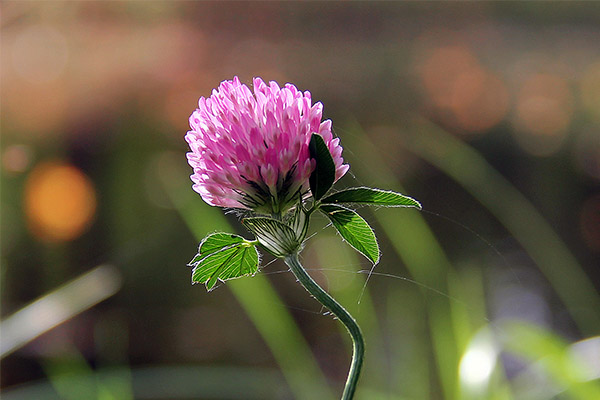
When burns and boils make lotions from decoction of inflorescences clover. The decoction can also be used to rinse the scalp and face wash for seborrheic dermatitis. It is used for baths for hyperkeratosis (thickening of the stratum corneum). In addition, warm decoction is used to treat acne by rubbing it over acne-covered areas of the skin.
Fresh clover juice or decoction rubbed into the roots of hair to avoid their premature graying.
So, clover meadow clover in cosmetology can be used as follows:
- Mask to moisturize the skin. Take 4 fresh inflorescences and the same number of leaves, crush, add 1 tablespoon of liquid honey and grind all the ingredients to a homogeneous consistency. The product is applied to the skin for 15 minutes, then rinse with cool water. The mask not only moisturizes, but also helps to smooth out fine lines.
- Eye area lotions. Take 1 tsp. crushed dried material for 100 ml. boiling water, infuse until cool, strain, then lower a cotton pad in this stuff, which is then put on the eyes for 20 minutes. At the end of the procedure, wash with the remaining decoction. The product smoothes the skin and relieves puffiness.
- Anti-aging mask for all skin types. Take 1 tablespoon of crushed fresh clover inflorescences and leaves, 1 raw egg, 1 tablespoon of kefir. All ingredients are mixed until a homogeneous consistency and applied to cleansed skin. Leave the mask for 20 minutes, then rinse with cool mineral water without gas. Because of the kefir product has some whitening effect, so do such a mask more than once a week is undesirable. The mask gives the skin firmness and elasticity, smoothes fine lines.
As for the other properties of clover, they can be used to give curls shine and strengthen the hair. To do this, you can use the following infusion - for 3 tablespoons of crushed dry raw materials take 2 cups of boiling water. The resulting remedy insist for three hours, covered with a lid, and then strain. This infusion is rubbed daily in the evening in the hair roots and scalp. It can be stored for two days in the refrigerator and then prepare a new portion.
Types of medicinal preparations
There are several options for using meadow clover. Below will be considered options for preparing remedies on its basis.
Tincture .
As a rule, alcoholic tincture is used only in the treatment of infectious diseases, in the complex treatment of malignant neoplasms, as well as an external remedy for various inflammations. But it has contraindications - it can not be drunk with high blood pressure, as well as it can not treat burns and areas affected by atopic dermatitis.
To prepare this remedy you need to take 4 tbsp. Spoonfuls of crushed dried raw materials in 0.5 liters of vodka or ethyl alcohol, which is diluted to a strength of 40 degrees with distilled water. The tincture is kept in a dry and dark place for 10 days, shaking occasionally. Thereafter it is taken 1 tsp. three times a day. Sometimes doctors recommend a smaller dosage.
If atherosclerosis does not increase blood pressure, but there is tinnitus, then take this tincture - 40 g of dried plant material for 50 ml of vodka. This remedy is drunk 20 ml daily before dinner for three months. The course of treatment may be repeated if necessary, but only after a break of 10 days.
To treat erectile dysfunction make a tincture of the seeds. To do this, take 1 tbsp. raw material, pour a glass of dry red wine and heat on a steam bath for an hour. The remedy is taken by 1 tbsp. spoon three times a day.
Infusion .
Take 2 tbsp. spoonfuls of dried herbal raw materials per glass of boiling water and insist for an hour, then filtered through two layers of gauze.
Decoction
There are two options for preparing this type of medicine. For the usual decoction, take 1 tbsp. dried inflorescences per glass of boiling water and leave on low heat for a couple of minutes, and then insist for an hour. Such a remedy should definitely be taken before a meal. The second option is a steeping decoction. He is considered more concentrated. For it take 3 tablespoons of raw materials per glass of boiling water.
In folk medicine, decoction of clover roots can also be used. Basically, this remedy is considered effective for diseases of the respiratory system. To prepare take 20 grams of dry crushed root and brewed with a glass of boiling water, then leave on low heat for half an hour. Then remove from the stove, cool and strain the remedy. It loses part of its volume, and it is restored with boiled water. This decoction is considered concentrated and is taken 1 tbsp. spoon up to 5-6 times a day.
Tea
This is the safest remedy of all listed, it can even be given to children to prevent SARS and improve digestion. Take 1 teaspoon of dried material and pour a glass of boiling water. Insist means no longer than 5 minutes. After that, it is drunk in small sips, stretching the volume for the day.
For the prevention of various diseases tea can be brewed in another way - 20 fresh inflorescences per 1 liter of water. Such a drink can be drunk almost without restrictions, but not longer than 7 days in a row. After that, you need to take a break for 3-4 days, and then you can drink another course.
Juice
The juice of meadow clover contains almost all the ingredients that are in the leaves and inflorescences, but only in a higher concentration. This is ascorbic acid, B vitamins, tocopherol, and tannins. Because of this, the juice has not only anti-inflammatory, but also antiseptic and even antipyretic properties. This makes it practically a universal remedy, which can be used for respiratory diseases, rheumatism, and for the treatment of burns and boils (it differs favorably from the alcoholic tincture). In addition, unlike decoction and water infusion, this remedy can also be used to treat diarrhea. In folk medicine, the juice is also considered effective in the treatment of some eye diseases and inflammation of the middle ear.
Clover juice can be used in cosmetology. It can be rubbed into the scalp instead of the decoction described above. It is used to wipe the face to make the skin smooth and velvety. It can also be used to prepare a unique mask for the neck and décolleté area - the juice is soaked in gauze, which is applied to the appropriate areas of the skin as a compress.
Juice, unlike plant raw materials, it is better to prepare before flowering, that is in May, maximum - in June. For this purpose, cut the above-ground parts of the plant together with the inflorescences. All of these raw materials are carefully sifted, discard withered and damaged parts, washed in cold water, then slightly dried and passed through a juicer. The entire resulting liquid is consumed almost immediately, you can not store it for a long time, even in the refrigerator, but for one course of treatment should be enough.
Juice has a high concentration of active substances, so it is recommended to drink it in a dosage of no more than 50 ml per day. Its taste is tart, it may seem unpleasant, to soften it, a small amount of honey is added to the drink.
Oil extract
This remedy can also be prepared at home. The above-ground part of clover contains essential oil and fatty acids, but to obtain the extract you need to take high-quality olive oil. To prepare the product dried branches and inflorescences of clover are taken, for 1 part of plant material pour 6 parts distilled water and leave in a dark and cool place for 24 hours. Then the infusion is brought to a boil and left over low heat until it is 2/3 evaporated. After that, pour the same amount of olive oil and keep on the heat until the water has evaporated completely.
The resulting oil, which should be strained and drunk every day to 1 tsp. spoon, for example, for joint pain or gynecological conditions. However, phytotherapists warn that if you exceed this dosage, you may have a sore throat.
Contraindications to use
Since clover contains phytoestrogens, it is contraindicated for pregnant women. After all, the effects of these substances can lead to miscarriage or premature birth. Because of the phytoestrogens, clover preparations are contraindicated in some cancers (mainly oestrogen-dependent tumors), since in such cases they can make things much worse.
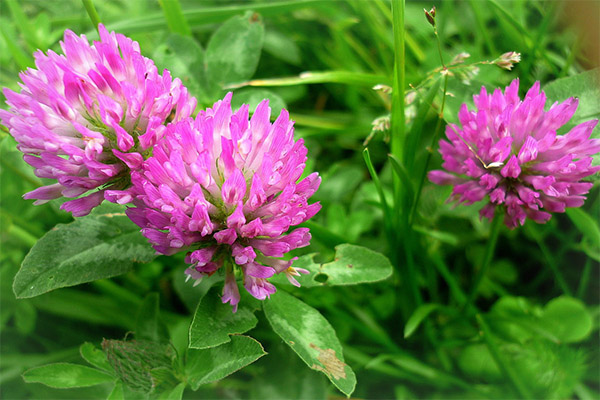
Clover preparations are also contraindicated in diseases such as thrombophlebitis and varicose veins. In no case can they be taken in pathologies of the cardiovascular system. Doctors also forbid it in case of a stroke.
Any infusions and decoctions of clover should not be taken with a tendency to diarrhea - it will only intensify. This plant is also contraindicated in case of stomach pain, including those caused by gastritis or peptic ulcer.
The use of preparations based on meadow clover sometimes leads to adverse reactions of varying severity - it may be as dizziness and skin rashes, and myalgia (muscle pain), episodes of nausea, vomiting and even uterine bleeding. If any adverse reactions occur, you should discontinue further medication.
Meadow clover-based remedies are not recommended to be used simultaneously with tablet estrogens (this can cause overdose). In no case can they be combined with liver enzymes and aspirin. Do not use them at the same time as heparin, as this can lead to the development of severe side effects.
Interesting Facts
Clover has become such a familiar crop that it seems as if it has always been grown. But in fact, it didn't begin to be cultivated until about 600 years ago in Northern Italy. From there it began to spread throughout Europe. First clover reached Holland, then the German principalities and England. In Russia it was introduced about 200 years ago.
In the old days, dried and crushed clover leaves were used, as we would say today, as a dietary supplement. They were ground into a powder and added to flour, which was then used to bake rye bread. Clover was also used as an additive in some European cheeses and sauces. Today, clover flour is primarily used in animal husbandry as it is a source of many valuable substances. Nevertheless, scientists continue to study the properties of clover, so perhaps new uses for it will soon be found.
«Important: All information on this site is provided for informational purposes only information on this site is provided solely for educational purposes. Seek medical advice before applying any recommendations. specialist before applying any of the recommendations. Neither the editors nor the authors shall be liable for any possible harm caused by materials."

